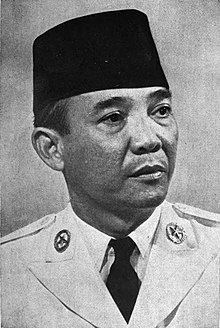Dutch East Indies
| Nederlands-Indië | |||||
| Dutch East Indies | |||||
|
|
|||||
| Official language | Malay , Dutch , regional dialects | ||||
| Capital | Batavia | ||||
| Form of government | Parliamentary monarchy | ||||
| Head of state | King of the Netherlands | ||||
| Head of government | Governor General | ||||
| population | 60,727,000 (estimate 1930) | ||||
| currency | Dutch East Indies Guilder | ||||
Dutch East Indies ( Dutch Nederlands-Indië , Indonesian Hindia-Belanda ), also known as the Dutch East Indies , was the forerunner of the Republic of Indonesia under Dutch rule .
United Dutch East India Company
From the early 17th century onwards, the United Dutch East India Company (VOC) was the dominant power in the archipelago . Founded in 1602, it took action very quickly against the Portuguese who then ruled the archipelago. At that time Portugal was a side country of Spain , which in turn was at war with the Netherlands. In 1605 Amboyna on the Moluccas was the first to be taken by the Dutch. In 1619, Batavia , today's Jakarta , was founded as the company's headquarters; the sovereignty was originally limited to its immediate vicinity. In the course of the 17th century, the most important ports of the archipelago were gradually captured: Malacca in 1641, Aceh in 1667, Makassar in 1669, and finally the British Bantam in 1682.
The economic backbone of the colony were spices that were grown in monocultures on the various islands : Amboyna specialized in cloves , Timor in sandalwood , and the Banda Islands in nutmeg . Cinnamon came from Ceylon , also in the Netherlands . Another important spice was black pepper . This was exchanged for cotton from India and silver from America . One of the most important sources of wealth, however, was trade within the archipelago (see also India trade ).
Takeover by the Dutch government after 1799
In the late 18th century, the VOC had long since become a “state within a state”. The preferred method of indirect rule over the Indonesian princes was continued by the Dutch state. After the dissolution of the VOC in 1799 and an intermediate phase during the Napoleonic Wars (1811 to 1816), in which the archipelago was conquered and administered by the British, the Dutch state took over administrative sovereignty. Insulinde was the only larger Dutch colonial area to be returned by the British. This process came to an end with the Treaty of 1824, in which Bengcoolen (today Bengkulu ), the British base on Sumatra , was exchanged for Malacca, the Dutch base on the Malay Peninsula , which permanently delimited the areas of influence of the colonial powers.
In the years between around 1890 and 1910, the area, including the hinterland of many islands on which the VOC had only established bases, was organized as a colony. The Dutch government completed the division of Nederlands-Indië into Gouvernements (Gouvernements) and Regentschappen (Regencies) and established a colonial administration. From 1908 (fall of Acehs) the entire territory of what would later become Indonesia belonged to the Dutch East Indies. The border with Portuguese Timor , which largely corresponds to the present-day border between Indonesia and East Timor , was finally established in 1916.
The population was about 37 million in 1900; 29 million of them lived on Java and Madura . About 80,000 Europeans and 550,000 ethnic Chinese lived in the colony.
Colonial troops
Already at the time of the East India Company, the majority of the soldiers deployed were recruited from German volunteers. This practice continued in the Koninklijk Nederlands-Indisch Leger . The proportion of non-Dutch among the European teams was well over 50 percent before 1900, later around a third. The locals were mainly recruited as “warlike” Javanese and the often Christian Ambonese . Auxiliary troops ( Marechaussee ) were still raised in the 1890s for guard services and to fight guerrillas in Aceh .
Second world war and independence
After the Japanese attack on Pearl Harbor on December 7, 1941, stated Dutch government in exile the Empire of Japan in cooperation with the United States , Britain and other countries to war. Between December 16, 1941 and March 8, 1942, the Japanese army conquered all of the Dutch East Indies. On March 9, took place against the attackers on the island of Java , the unconditional surrender . The area remained in Japanese hands until the end of the war in 1945. The Indonesian national movement under Sukarno and Mohammad Hatta was tolerated and supported by the occupiers.
On August 17, 1945, the Republican Sukarno declared the Dutch East Indies independent after the surrender of Japan . However, the Netherlands did not recognize this, but tried to restore their power. In a transitional phase, Japanese troops continued to be responsible for law and order, controlled by the British, by arrangement. During this time, the Republicans managed to rule large parts of the main island of Java and some other areas. In two military actions, euphemistically called "police actions", the Netherlands conquered many areas of the Republicans, but the global public condemned this, including the USA , on whose financial aid the Netherlands depended.
The Dutch recognized Indonesia's independence on December 27, 1949, but retained sovereignty over Dutch New Guinea , which in 1954 caused the agreed cooperation in the Dutch-Indonesian Union to fail. It was not until 1962, under pressure from the United States, that the Netherlands agreed to the transfer to Indonesia in the New York Agreement . The intention of the Netherlands to found a new state with the name of the Republic of West Papua could therefore not be realized. A short time later, the western part of the island was taken over by Indonesia. A referendum of the Papuans on membership of Indonesia, the Act of Free Choice of 1969, introduced as a condition of the New York Agreement by the Netherlands , was manipulated by Indonesia in its favor, but officially recognized by the UN.
coat of arms
The coat of arms of the Dutch East Indies is similar to the queen's coat of arms of the Netherlands , but differs from this in the splendid pieces : The red crowned coat of arms with ermine lining is missing .
Description of the coat of arms : In blue, a golden, red-armored and also tongued, gold-crowned lion wielding a gold-tipped silver sword with his right paw and in the other holding a golden bundle with seven arrows. The shield, held by two golden, red-armored and tongued lions, is studded with golden shingles and crowned with the golden Dutch royal crown.
Under the shield there is a blue ribbon with the coat of arms in silver capitals and in French Je maintiendrai meaning “I will exist”.
See also
- List of Governors General of the Dutch East Indies
- Administration of the Dutch East Indies
- Klaas van der Maaten
- Trip to Batavia
literature
- Ulbe Bosma: Emigration: Colonial circuits between Europe and Asia in the 19th and early 20th century. In: European History Online . ed. from the Institute for European History (Mainz) , 2011, accessed on: May 18, 2011.
Web links
- Dutch East Indies pictured 1860-1940 on "Het Geheugen van Nederland"
- The "Afscheid van Indië" project
- Pictures from the Dutch East Indies on "Het Geheugen van Nederland"
- "Het Indian Filmarchief"
- Documentary about the Dutch East Indies on School TV (Dutch)
Individual evidence
- ^ Johannes Coenraad Kielstra: The Dutch colonies in South-East Asia in world traffic (= Kiel lectures, held in the Institute for World Economy at the University of Kiel , Volume 7). Commission publisher by Gustav Fischer, Jena 1922, p. 6.
- ^ Gerke Teitler: The Mixed Company. Fighting power and ethnic relations in the Dutch Colonial Army, 1890-1920 . In: Karl Hack, Tobias Rettig (Ed.): Colonial Armies in Southeast Asia . Routledge, Abingdon 2006, ISBN 0-415-33413-6 (= Routledge studies in the modern history of Asia , vol. 33), pp. 154-168, here p. 155.
- ^ Gerke Teitler: The Mixed Company. Fighting power and ethnic relations in the Dutch Colonial Army, 1890-1920 . In: Karl Hack, Tobias Rettig (Ed.): Colonial Armies in Southeast Asia . Routledge, Abingdon 2006, pp. 154-168.
- ↑ Decision at Midway. In: The History of the Art of War. Retrieved July 19, 2008 .
- ↑ Meyer's pocket dictionary of flags and coats of arms. Bibliographisches Institut Leipzig 1980, p. 176.
Coordinates: 2 ° S , 118 ° E




